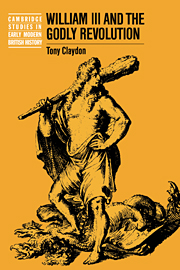Book contents
- Frontmatter
- Contents
- List of illustrations
- Acknowledgements
- List of abbreviations
- Notes on style
- Introduction
- 1 Courtly reformation and the revolution of 1688–1689
- 2 The resources for royal propaganda
- 3 The propagation of courtly reformation
- 4 Courtly reformation, the war, and the English nation
- 5 Courtly reformation and the politics of party
- 6 Courtly reformation and country politics
- Conclusion
- Bibliography
- Index
- Cambridge Studies in Early Modern British History
5 - Courtly reformation and the politics of party
Published online by Cambridge University Press: 09 October 2009
- Frontmatter
- Contents
- List of illustrations
- Acknowledgements
- List of abbreviations
- Notes on style
- Introduction
- 1 Courtly reformation and the revolution of 1688–1689
- 2 The resources for royal propaganda
- 3 The propagation of courtly reformation
- 4 Courtly reformation, the war, and the English nation
- 5 Courtly reformation and the politics of party
- 6 Courtly reformation and country politics
- Conclusion
- Bibliography
- Index
- Cambridge Studies in Early Modern British History
Summary
WHIG AND TORY UNDER WILLIAM III
One of the most remarkable features of William's invasion of England in 1688 was the degree of support it received from both whigs and tories. For a few brief weeks over the winter, old enemies united in defence of the protestant religion, and in agreement that James could no longer be trusted with the exercise of uncontrolled monarchical power. Whigs such as Wharton and Montagu, who pressed William's case amongst the political elites in London, were joined by tories such as Sir Edward Seymour, flocking to the prince's banner in the West Country. On coming to power, William tried to capitalise upon this broad alliance, and attempted to unite his new realm behind his new regime. The ministry he first constructed combined men of both parties in an attempt to force them to work together, and to bury factional jealousies for good. William balanced a whig Secretary of State, the earl of Shrewsbury, with a tory one, the earl of Nottingham, and constructed a Treasury Commission from men of differing political backgrounds. Whilst the royal household, judiciary, and admiralty were mainly whig preserves, the marquis of Halifax, who was no species of whig, was made Lord Privy Seal, and a leading tory, the earl of Danby, was promoted to the marquisate of Carmarthen, and to the Lord Presidency.
- Type
- Chapter
- Information
- William III and the Godly Revolution , pp. 148 - 190Publisher: Cambridge University PressPrint publication year: 1996

